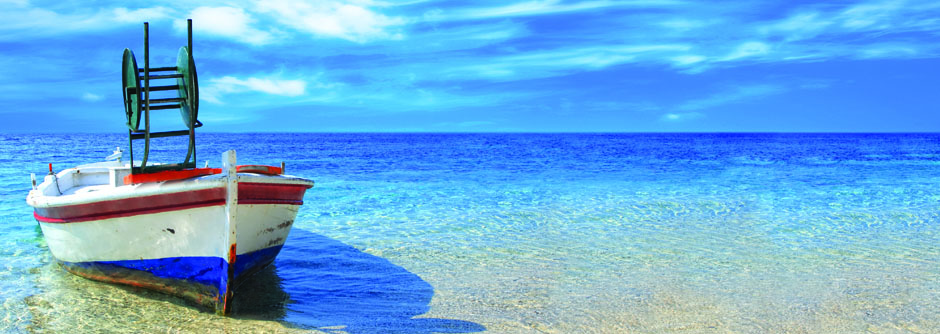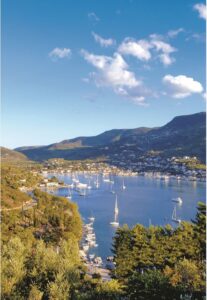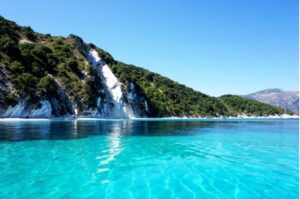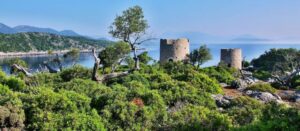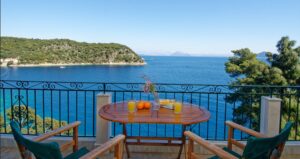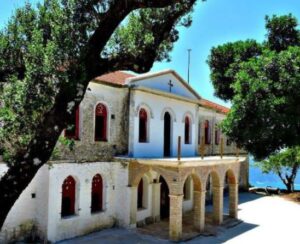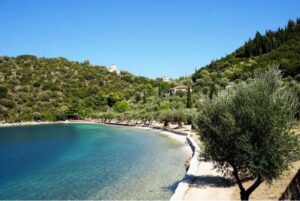….a brief history of Ithaka.
Ithaka must be the most famous but least known of all the Ionian islands. Immortalised by Homer as Journey’s End for Odysseus, conqueror of Troy, this small Ionian Island is often overlooked by travellers in favour of its larger neighbours.
Kefalonia, the biggest island in the Ionian was already a popular holiday destination long before the huge success of its own epic romantic adventure, Captain Corelli’s Mandolin by Louis De Bernieres, but for many people Ithaka remains a mythical place, vaguely recalled from school lessons in ancient history.
Nothing co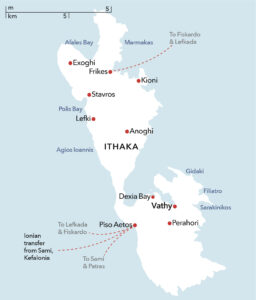 uld be further from the truth, for the real Ithaka possesses a combination of the natural beauty and culture of all of the Ionian islands rolled into one. Many small islands are either perfect for that away from it all holiday, but require an Odyssey to reach, or are so easily accessible that half the world and its dog seem to have discovered them! Ithaka, however, is the perfect compromise, being fortunate enough not yet to have had an airport erected and the influx of mass tourism which that usually brings, but still easily reached by a short boat ride from Kefalonia.
uld be further from the truth, for the real Ithaka possesses a combination of the natural beauty and culture of all of the Ionian islands rolled into one. Many small islands are either perfect for that away from it all holiday, but require an Odyssey to reach, or are so easily accessible that half the world and its dog seem to have discovered them! Ithaka, however, is the perfect compromise, being fortunate enough not yet to have had an airport erected and the influx of mass tourism which that usually brings, but still easily reached by a short boat ride from Kefalonia.
So, what exactly is this secret allure of Ithaka?
Despite the attentions and fierce debates of archaeologists and classic historians, the Odyssey remains as one of the world’s greatest romantic epics, even though it describes an age and events that vanished 3,500 years ago. Perhaps the subtle echoes of Homer’s masterpiece can still be heard in the ancient palaces and the artefacts discovered within their ruined walls. Almost without exception those that have found their way to Ithaka plan to return, such is the magic of those subtle echoes!
However, Ithaka is much more than a sleepy, romantic island locked into a mythical time warp. Odysseus was only the first in a long line of Ithakian men who have sailed across the oceans of the world. This connection with foreign lands means that there is a real cosmopolitan feel to the island that blends with the islanders’ natural hospitality and their spirit of independence. Once seen as Kefalonia’s poor relation, Ithaka now has its own administration which allows for more control over the development of their island and recent years have seen major improvements in the infrastructure. Most homes and businesses are owned and run by the islanders themselves and whilst political differences are vigorously expressed (Ithaka is in Greece when all’s said and done!) everyone agrees that the uniqueness of the island must be protected.
Between the island capital, Vathy in the South and village of Stavros in the North, there are five or six other settlements, clinging to the mountain sides or clustered around the picturesque bays of the island’s east coast. Each has its own character and appeal. The years of economic emigration, which saw the island population decline from about 15,000 when British rule ended in the mid-19th Century to the present 3,000, seems to have stopped. School registers are rising, new businesses have started and low impact tourism, based on family-owned apartments and traditional villas, is an important growing feature of the local economy.
One of the great joys of Ithaka, especially after crowded urban motorways and long hours trapped in a car is that the island is small enough to drive around in an hour, but big enough to wander off the beaten track and explore the network of old mule paths and shepherds’ trails which are being opened up by a small but enthusiastic group of local people.
Many of the trails lead to natural features straight out of Homer; “Arethusa’s Spring”, the “Nymphs and Eumaios Caves”, “Laertes Field”, all can be easily reached on foot, as well as the shapely if diminutive peak of Aetos, the Eagle, reputedly the site of the hero’s palace, where Penelope waited faithfully for his return. Arguably Ithaka’s finest viewpoint, with the Ithaka Channel and Kefalonia on one side and island dotted waters of the inner Ionian Sea on the other, the ascent involves a short, sharp climb passing the impressive Cyclopian defensive walls. Other tracks wind through natural oak woodland and olive groves to old windmills, ruined Byzantine churches, their frescoes faded but still glorious and unspoilt coves.
Nightlife on the island revolves around the plateias or squares. Every village has one and throughout the summer a series of religious festivals are celebrated. These all-night affairs, where the wine flows freely and songs and traditional dancing are enjoyed by the whole community, young and old, should not be missed.
These “Panagiria” are not contrived tourist occasions full of Zorba wannabes and plate smashing, but merely the Greeks doing what they do best, providing hospitality and enjoying themselves! Ithaka is neither a ‘grand’ not ‘in’ holiday destination, at least in the context of the trade writers’ world of hyperbole and fashion, nor is it a small island lost in time and obsessed with an ancient myth. It has taken on board the trappings of everyday life in modern Europe, ATMs, internet cafes, satellite television, good communications and last but not least, modern plumbing! New cars are readily available to hire, road surfaces have been improved, restaurants and shops modernised, air conditioning and swimming pools have been installed, but in the process has not lost sight of its soul. It is an island where a holiday can easily become a way of life!
Vathy
Vathy is one of the most spectacular natural harbours in Greece. Almost invisible from the sea, its narrow fjord-like entrance, guarded by twin headlands, each with the ruins of Venetian gun emplacements, is protected by the huge bulk of Mt Neritos, the island’s highest peak. Once inside the bay opens up to reveal a small town clustered around the far shore.
Although much of Vathy was devastated in the great earthquake of 1953, when many of its classic Venetian style mansions were destroyed, planning controls have ensured that the town has kept its character with well-proportioned houses, carefully painted facades and traditional roofs. It is the administrative capital and main ferry port of Kefalonia and Patras on the mainland. The countryside in the immediate vicinity is glorious. Quiet lanes and tracks lead up the fertile valley behind the town from where newly opened footpaths can be taken to places straight out of Homer’s Odyssey.
The town itself contains fascinating alleyways and stepped paths often lined with the walls of elegant ruins, their archways and windows covered in wisteria.
Vathy is excellent for shopping. There are three banks with cash machines and foreign exchange facilities, a post office, health centre, museums and a theatre. Throughout the summer, concerts, plays and events are held here or in the main plateia and in July and August there is often a street market where local wines, olives, olive oil and honey can be bought.
Around Vathy there are many coves within easy walking distance or a short drive; perhaps the best is the secluded Gidakhi beach which can be reached by a delightful stroll through pine trees and a unique tree heather forest or thirty-five minutes by water taxi. The water taxis leave in the morning and return in the late afternoon.
Gidakhi has a stunning white pebble beach, like the majority of beaches on Ithaka, with one taverna serving drinks and light traditional snack as calamari, salads and sandwiches. Other beaches worth visiting in the South are Filiatro, Minimata, Skinos and Sarakiniko. There are also regular boat trips to the inner islands, like Atokos and Kalamos. Self-drive boats can also be hired for further exploration of the coastline.
Only two kilometres from Vathy is the Cave of Nymphs, a cave steeped in myth and history and where, legend has it the Naiads, or Water Nymphs lived, who were worshipped by the ancient Greeks. It is also believed that it was here that Odysseus hid the gifts he had brought with him from the island of the Phaeacians after his return from Troy and his two-year wanderings.
Also well worth a visit is Perachori, a spectacularly situated village on the side of a mountain provides superb views across the inner Ionian Sea to the mainland hills and a number of 15th Century churches with preserved frescoes. Perachori is famous for its excellent local wine and holds a wine festival every year at the end of August.
Perachori is also the gateway to the ancient capital of the island, Paliochora or Epano Chorio with its impressive defensive architecture, stone houses and ruined Byzantine churches. This ancient settlement remained the capital of the island until the 16th century when development began closer to the coast and Vathy began to take shape.
On summer evenings everyone makes their way to the plate beside the harbour, the road is closed off to traffic except where children on their bicycles race ahead of their parents enjoying a traditional ‘volta’ or stroll before their evening meal.
AGIOS IOANNIS
This tiny village on the east coast has one of the best beaches around. A recent landslide means you have to park a bit further up the road, but it’s only 5 minutes down to the sea. There are plenty of car parking spaces. There’s a big house above the beach, owned by a millionaire, he’s even got ostriches wandering around in the garden! The water is a bit cooler here which can be an advantage on a really hot summer’s day. Ithaka is virtually two islands, connected by a narrow ridge with Mt Aetos at its centre.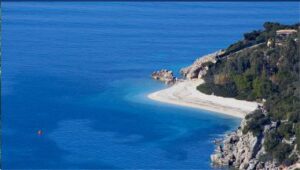
Although small, the island is diverse and there is even an amicable North/South divide amongst the inhabitants, with talk of border controls and passports between the two halves! While Vathy is the cosmopolitan hub of the south, the North is very different in character, although it shares a similar mountainous interior.
STAVROS
This is the second largest village on the island and is famous for its summer fiesta which lasts for two days (non-stop!). There’s always a live band playing a mixture of traditional Greek songs and pop.
Everyone joins in the dances and it doesn’t matter if you don’t know the steps. Even the old grannies boogie when they change to rock!
Stavros is the central village of northern Ithaka and has a small selection of tavernas and traditional fish restaurants, shops and a bank with an ATM. There is also an excellent but very small archaeological museum where the curator speaks excellent English and will be happy to answer any queries you may have.
EXOGI
From Stavros you can drive up a twisty mountain road to this tiny hill village (whose name means the far or out place). It’s a fairly sleepy little place nowadays but worth a visit for the fantastic views and the mysterious pyramids above the village. They were built by an eccentric poet who apparently also buried treasure somewhere nearby. He carved coded clues into the rocks and walls all around which, if deciphered will lead you to the hoard. No-one’s managed it yet! There’s also another festival here in the summer – but only for one day this time.
KIONI
This pretty village escaped most of the destruction of the earthquake of 1953 and strict planning regulations have preserved the Venetian architecture of the settlement. The tiny harbour with its cluster of waterfront tavernas and shops is still used by traditional fishing boats, as well as being a popular port of call for visiting yachts.
There are little beaches all around the harbour and a bigger one on the far side, near the old windmills, called Cemetery beach. Although, don’t worry, the graveyard is positioned well back from the shore! Naturally, Kioni also has a festival.
PILICATA
One kilometre north of Stavros, excavations on this hillside which is between the bays of Polis and Frikes brought to light remains of a small Bronze Age settlement. The finds unearthed there reinforce the theory that the ancient city of Ithaka lies somewhere in the vicinity.
ANOGHI
If you feel like a bit of exercise, there’s a superb old mule track, now a footpath which climbs all the way up the wooded mountainside to the village of Anoghi. The present settlement in this village dates from 16th Century but the original 13th Century village, now ruined, lies a little higher up the hill. The church here, despite its unremarkable exterior contains some of the best frescoes in the region. To gain entry to the church the village Kafenion, next to the Venetian bell tower will supply you with a key. The Kafenion is also worth a visit barely having changed in a hundred years.
This completely authentic meeting place was chosen as the model for the Kafenion in the recent film of Captain Corelli’s Mandolin.
FRIKES
From Stavros, the road leads down to the sleepy waterfront village of Frikes with a choice of several tavernas, two beautifully preserved windmills and a picturesque location, the village is a popular choice with our visitors to the north of Ithaka. You can catch a daily ferry from here to Fiskardo and Vasiliki. There are boats to rent and further up the coast, only easily accessible by sea is Marmakada beach. There’s a tiny island just offshore which has a chapel on it and a large flock of chickens.
The farmer rows out every day to feed them and collect the eggs. The reason he keeps his hens out there is that there are many pine martens on the main island and they like nothing better than to bite off and eat a chicken’s head, which doesn’t help with egg laying.
LEVKI
On the opposite side of Niritos, in a spectacular location overlooking the Ithaka Channel and the mountains of Kefalonia is the village of Levki, which straddles the main road. Levki means white and each year just before Easter the inhabitants get together with their buckets of whitewash and repaint the entire village!
They are also very proud of their gardens and each plot is a riot of bougainvillea, jasmine, citrus trees and geraniums. Levki also has strong links with Britain. During the last war and following the invasion of the Ionian Islands by the Axis forces, the village was used as a base by the Greek Resistance. Outwardly it remained much as before, a sleepy settlement of farmers and smallholders quietly going about its business and therefore of little interest to the Italian and German occupiers.
However, there were more than just the odd goat or sheep in the old barns and store sheds in the surrounding vineyards and olive groves. Escaped allied prisoners, shot down pilots and members of the Special Operation Executive, from all over the eastern Mediterranean, but particularly Crete, were hidden by the villagers, whilst en route back to the United Kingdom. When the village was destroyed in the great earthquake Britain gave money, labour and materials for its reconstruction, in gratitude for this unsung and highly dangerous contribution to the allied war effort. Most visitors pass through this village on their way to Vathy.
TOP PLACES TO VISIT IN ITHAKA
KIONI
The traditional village of Kioni is located 20km north of the capital, Vathy – lying on the north-eastern coast of the island. Throughout the years, since its establishment in the 16th century, the village of Kioni has seen a number of devastating earthquakes, but its people have done well in protecting and preserving their hometown.
THE CAVE OF THE NYMPHS
South of Vathy, away from Aetos and left before Dexia beach, you will find the cave, also known as marble cave, with two entrances. Myth has it that one entrance was used for the mortals and the other for the Gods. Following a narrow path from the entrance, you will find a flat 7-metre-wide chamber. Lit up by an opening on the ceiling, the chamber is decorated by coloured stalactites and stalagmites. Either a torch or a flashlight would come in handy while finding your way out.
THE MONASTERY OF KATHARA
A loop road branches off above the beach at Aetos, zigzagging up to the lonely 16th century monastery of Kathara, high on the slopes of Neritos, the island’s highest mountain. From the bell tower near the church, the eagle’s eye view of Molos Bay and Vathy harbour far below is magical.
The view across the sparkling sea to the Gulf of Corinth and the Peloponnese mountains, is one of the finest in the whole of Greece. Further on the road passes through the isolated village of Anoghi, where an unassuming small church contains a magnificent series of late 15th century frescoes.
NAVAL-FOLKLORE MUSEUM
Housed in Vathy, under a 1923 old electric power station, the museum exhibits paintings and findings that depict Ithaka’s long naval history and tradition. In addition to the naval apparatuses and instruments, the museum exhibits folklore gatherings providing you with a good eye of the local everyday life of island’s inhabitants throughout the 20th century.
TOP BEACHES IN ITHAKA
FILIATRO
At 20 minutes from Vathy, you will find Filiatro beach – one of the most popular beaches on the island, even for the locals. A family-friendly pebbly beach, where the water is warm, crystal clear and the surroundings are green – nature at its best.
AGIOS IOANNIS
One of the very few sandy beaches on the island, with turquoise waters, that is worth a visit. At 9km from Vathy, the easiest way to get there is using the steep track from Levki. The beach is surrounded by magnificent white rock cliffs and boasts crystal turquoise waters.
DEXIA BAY
Very popular among the Greeks, Dexia is one of the cleanest Greek beaches – awarded the Blue Flag. Rumour has it that Odysseus landed there when he got back to Ithaka from his 10-year long journey. Just off Vathy, at 2km from the capital and
on your way to Aetos, you will enjoy a blend of sand and pebbles giving to clear blue waters and natural shade from the trees surrounding the beach. Dexia also has a lifeguard as well as a beach bar.
AETOS BEACH
Aetos, located at 3km west of Vathy, is a pure, pretty and unspoilt beach with warm waters and a lovely atmosphere. You can see the beach from Vathy, as its not far from the capital of Ithaka, but still a peaceful and quiet shore to enjoy.
PLATIA AMMOS BEACH
Platia Ammos is Ithaka’s treasure-beach. Like most beaches on the island, Platia Ammos is surrounded by beautiful trees and like Agios Ioannis its shore is sandy and the waters are turquoise. You can only access the beach on a boat from Afales bay and you will usually find yachts and boats off the coast enjoying the crystal waters and the view of the majestic sand cliff behind and over the beach.
VILLA ACCOMMODATION IN KEFALONIA
We have a complete offering of fabulous accommodation options on the beautiful island of Ithaka, with villas and apartments of various sizes located in the North and South of the island. We know Ithaka very well, as this island is right next to our motherland which is Kefalonia.
For more information about exploring Kefaloni Island and our selection of villa holiday options, speak to our team on 0208 459 0777 or mail@ionianislandholidays.com.
